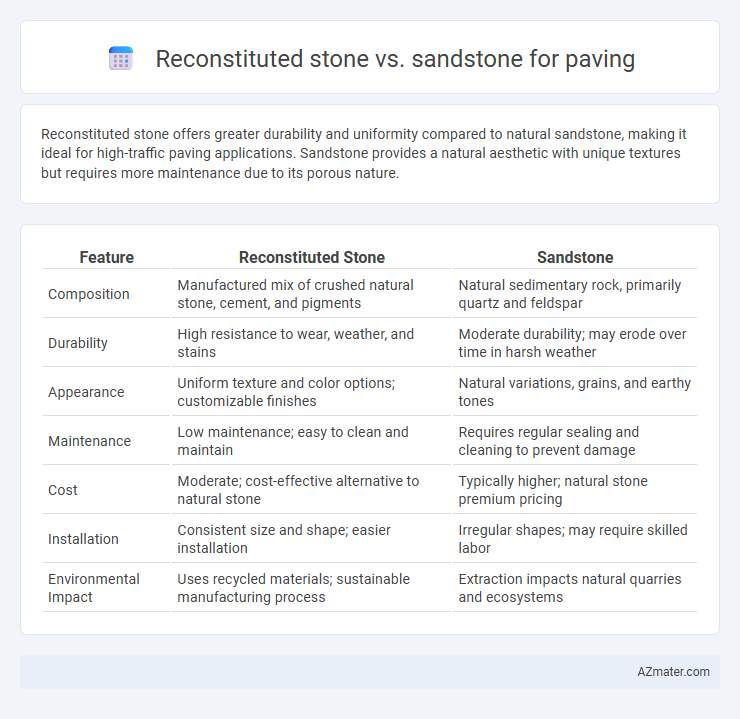Reconstituted stone offers greater durability and uniformity compared to natural sandstone, making it ideal for high-traffic paving applications. Sandstone provides a natural aesthetic with unique textures but requires more maintenance due to its porous nature.
Table of Comparison
| Feature | Reconstituted Stone | Sandstone |
|---|---|---|
| Composition | Manufactured mix of crushed natural stone, cement, and pigments | Natural sedimentary rock, primarily quartz and feldspar |
| Durability | High resistance to wear, weather, and stains | Moderate durability; may erode over time in harsh weather |
| Appearance | Uniform texture and color options; customizable finishes | Natural variations, grains, and earthy tones |
| Maintenance | Low maintenance; easy to clean and maintain | Requires regular sealing and cleaning to prevent damage |
| Cost | Moderate; cost-effective alternative to natural stone | Typically higher; natural stone premium pricing |
| Installation | Consistent size and shape; easier installation | Irregular shapes; may require skilled labor |
| Environmental Impact | Uses recycled materials; sustainable manufacturing process | Extraction impacts natural quarries and ecosystems |
Introduction to Paving Materials
Reconstituted stone combines crushed natural stone with resin or cement binders, offering enhanced durability and design flexibility compared to traditional sandstone, which is a natural sedimentary rock composed mainly of quartz and feldspar. For paving, reconstituted stone provides consistent color and texture, better resistance to weathering and erosion, and lower maintenance requirements, while sandstone is valued for its natural aesthetic, warmth, and slip resistance. Choosing between the two depends on factors such as budget, desired appearance, climate conditions, and longevity needs for outdoor paving projects.
What is Reconstituted Stone?
Reconstituted stone is a composite material made by blending crushed natural stone with cement and pigments, then molding it into paving slabs or tiles. It offers consistent color and texture, enhanced durability, and reduced porosity compared to natural sandstone. This engineered alternative provides greater resistance to weathering and staining, making it ideal for outdoor paving applications where longevity and aesthetic uniformity are priorities.
What is Natural Sandstone?
Natural sandstone is a sedimentary rock composed primarily of sand-sized mineral particles, mainly quartz and feldspar, cemented together by silica, calcium carbonate, or iron oxide. It is formed over millions of years through sediment deposition, compaction, and mineral cementation, resulting in a durable and aesthetically appealing material widely used for paving due to its natural texture and color variation. Unlike reconstituted stone, natural sandstone offers unique geological patterns and varies in porosity and hardness depending on the quarry source.
Appearance and Aesthetic Differences
Reconstituted stone offers a more uniform and customizable appearance with consistent coloration and texture, making it ideal for modern and sleek paving designs. Sandstone features natural variations in color, grain, and pattern, providing a unique, organic aesthetic that enhances rustic or traditional landscapes. The choice between reconstituted stone and sandstone depends on whether a controlled, polished look or a naturally diverse, authentic appeal is preferred for the paving project.
Durability and Longevity Comparison
Reconstituted stone offers enhanced durability compared to natural sandstone due to its engineered composition that resists cracking, chipping, and weathering. Sandstone, while aesthetically appealing with its natural variations, tends to be more porous and susceptible to erosion, reducing its longevity in high-traffic or harsh weather conditions. Investing in reconstituted stone paving ensures a longer lifespan and better performance under heavy use and environmental stress.
Maintenance Requirements
Reconstituted stone requires less maintenance compared to natural sandstone due to its enhanced durability and resistance to weathering, stains, and moss growth. Sandstone, being a porous natural material, often needs regular sealing and more frequent cleaning to prevent discoloration and erosion. Choosing reconstituted stone for paving ensures lower upkeep costs and longer-lasting aesthetic appeal in high-traffic outdoor areas.
Cost Analysis: Reconstituted Stone vs Sandstone
Reconstituted stone offers a more cost-effective solution for paving compared to natural sandstone, with prices typically 30-50% lower due to its synthetic manufacturing process and faster production times. Sandstone, sourced and quarried naturally, involves higher extraction and transportation costs, often leading to increased overall expenses for large paving projects. Maintenance costs also favor reconstituted stone, as it generally requires less frequent sealing and repairs than the more porous and weather-sensitive sandstone.
Environmental Impact and Sustainability
Reconstituted stone for paving offers a sustainable alternative by utilizing recycled materials and reducing quarrying impacts associated with natural sandstone extraction. The production of reconstituted stone typically consumes less energy and minimizes habitat disruption compared to the extensive mining of natural sandstone, which often leads to significant landscape alteration and resource depletion. Sandstone, while durable and natural, presents higher environmental concerns due to its non-renewable nature and the carbon footprint involved in quarrying, making reconstituted stone a more eco-friendly choice for sustainable paving projects.
Installation Process and Considerations
Reconstituted stone offers a more uniform shape and size, simplifying the installation process compared to natural sandstone, which often requires more precise fitting due to its variability. Sandstone's natural porosity demands thorough sealing to prevent water damage, whereas reconstituted stone generally has enhanced resistance to weather and staining, reducing maintenance needs. Proper substrate preparation and choosing compatible adhesives are critical for both materials to ensure long-lasting, durable paving.
Which is Best for Your Project?
Reconstituted stone offers consistent texture and color with greater durability and lower maintenance compared to natural sandstone, making it ideal for high-traffic paving projects. Sandstone provides a natural, unique aesthetic with authentic weathering properties, preferred for heritage or rustic designs but may require more upkeep due to its porous nature. Choosing the best option depends on project goals, budget, and desired longevity, with reconstituted stone often favored for performance and sandstone for visual character.

Infographic: Reconstituted stone vs Sandstone for Paving
 azmater.com
azmater.com